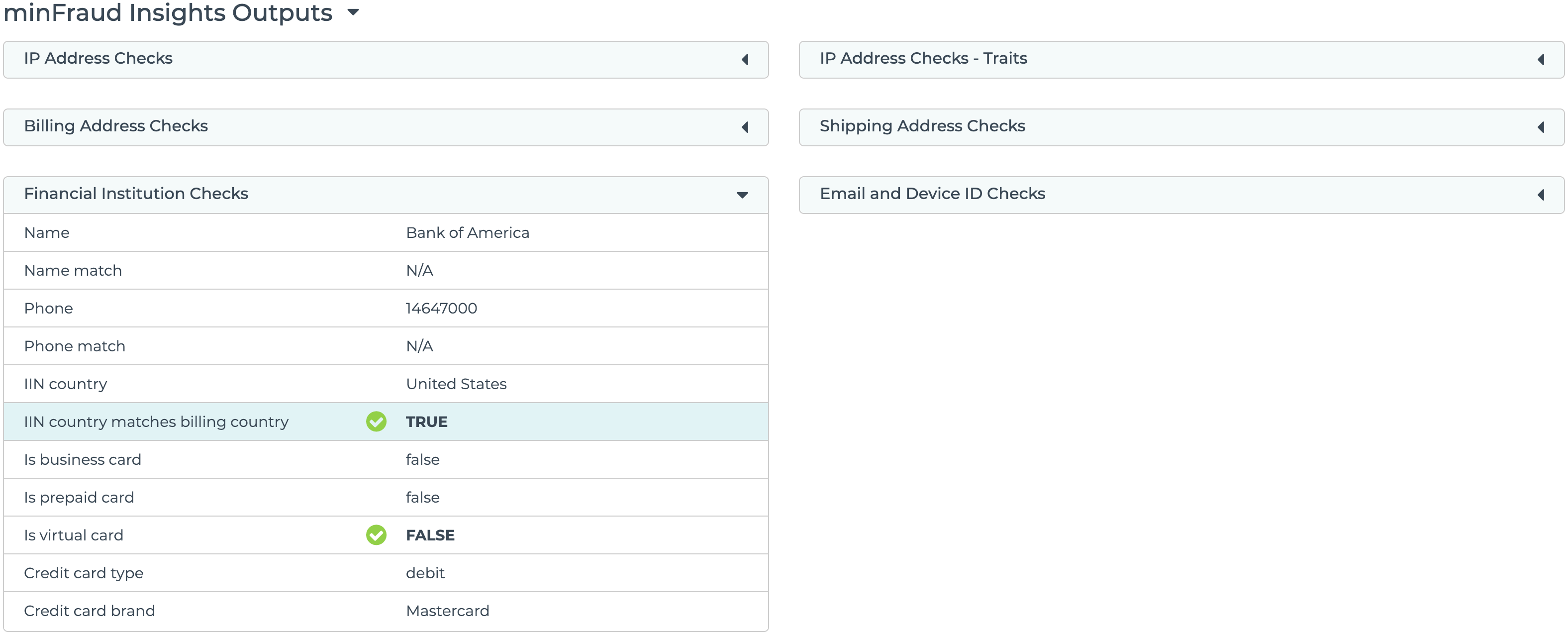Billing and shipping address risk data
Billing and shipping address risk data includes:
- flagging high-risk shipping addresses,
- measuring the distance between the billing and shipping addresses,
- detecting whether the user-provided postal code matches the city for billing and shipping addresses,
- checking the IP geolocation against the billing and shipping addresses,
- and checking the billing address against the credit card issuer.
These data points will only be returned when you pass the billing and shipping address and related inputs to the minFraud Insights and Factors web services. Learn more about passing inputs to minFraud.
Shipping address reputation flagging
If a shipping address engages in risky activity for your account, we will flag the address as high risk.
High risk shipping address flags are not displayed when reviewing transactions through the account portal, but they are returned as part of the API response.
You can read the API specifications for high risk email flagging on our developer portal:
Shipping to billing address distance
The distance between the shipping address and the billing address may indicate higher risk in certain circumstances, but it may also indicate that a customer is shipping something to a friend, family, or business. Check other details of the transaction to confirm.

The distance between the shipping and billing address is displayed under Shipping Address Checks in the transaction review screen in the account portal. Learn how to review transactions using the account portal.
You can read the API specifications for shipping to billing address distance on our developer portal:
Postal to city matching
This data point will tell you whether the postal code for the billing or shipping address is in the city for the address. If it is not, it may be missing from our database, or it may be due to a customer typo, or an indication that the address is not legitimate.

Postal code to address matching is displayed under Billing Address Checks and Shipping Address Checks in the transaction review screen in the account portal. Learn how to review transactions using the account portal.
You can read the API specifications for postal to city matching on our developer portal:
IP geolocation to address matching
For both the billing and shipping address, the minFraud service provides a data point which tells you the distance in kilometers to the geolocation of the IP address associated with the transaction, and a flag that tells you whether these addresses are in the same country as the IP address. If the IP address is far away from the billing or shipping addresses, it may indicate that a customer is traveling, or it may be more indicative of risk. You must pass the IP address in order to receive this data.
Consider whether this behavior is expected for your business, and cross reference this number with the confidence values and accuracy radius for our IP geolocation to get a sense of how accurate this value is for this transaction. Learn more about confidence values and accuracy radius in our IP geolocation risk data.

IP geolocation to address matching is displayed under Billing Address Checks and Shipping Address Checks in the transaction review screen in the account portal. Learn how to review transactions using the account portal.
You can read the API specifications for IP geolocation to address matching on our developer portal:
/billing_address/distance_to_ip_location/billing_address/is_in_ip_country/shipping_address/distance_to_ip_location/shipping_address/is_in_ip_country
Billing address and credit card country matching
The minFraud services will check to see whether the billing address is in the same country as the issuing bank of the credit card, when the issuer ID number of the credit card is provided in addition to the billing address.
There may be legitimate reasons that a card does not have a billing address in the same country that it was issued. This is more common with prepaid and virtual cards, when the issuing bank for these cards sell them in several different countries. Sometimes government employees stationed in other countries, such as embassy or military personnel, will have credit cards issued by banks in their home country, but billing addresses in the country where they are stationed.
You can check the credit card type and other details of the transaction to see whether there are other indicators of risk. Learn more about credit card type and other credit card risk data.

Credit card country to billing address matching is displayed as "IIN country matches billing country" under Financial Institution Checks in the transaction review screen in the account portal. Learn how to review transactions using the account portal.
You can read the API specifications for credit card country to billing address matching on our developer portal: